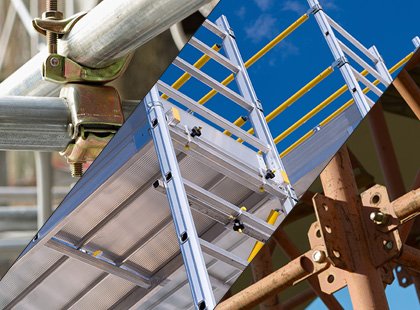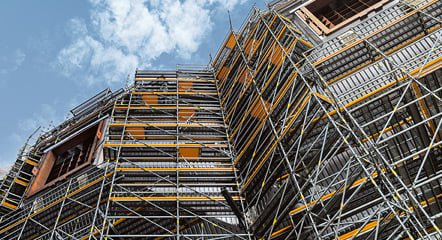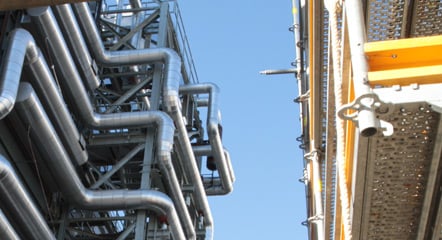What Are the Different Types of Scaffolding?
 A Look at the Different Types of Scaffolding and Their Uses
A Look at the Different Types of Scaffolding and Their Uses
Industrial scaffolds must be safe, secure, cost-effective and easy to build. Depending on the project, different types of scaffolding might be necessary. Here’s an overview of the industrial scaffolds most frequently in use and their advantages for various types of projects.
Cantilever Scaffolding
Cantilever scaffolding builds up a complex scaffolding structure on single “needle” points of contact, which are then further supported along the wall. This type of scaffolding is largely used when the footprint of the scaffolding needs to be small, such as when additional construction is occurring near a busy roadway or public walkway.
With each subsequent tier, cantilever scaffolding can get wider. The first layer might be three feet, then six feet, then nine feet and so forth. This allows for greater levels of workspace the higher up the scaffolding builds.
This can also be called “single frame type” scaffolding, and it doesn’t have to become larger as it goes: the distinguishing factor is merely that the footprint is smaller than the platform.
Double Scaffolding
Double scaffolding is ideal on walls that can’t support scaffolding, such as stone walls that workers can’t drill into. Instead of the scaffolding being propped up against the wall, the scaffolding is instead double built — with two sides supporting the structure. Double scaffolding is often called “mason’s scaffolding” because it’s effective without damaging the wall or when the full wall must be exposed.
This is an extremely strong form of scaffolding and can be used for many purposes, but it may be overkill for situations in which single scaffolding can still work well. Because it requires more materials than single scaffolding, it’s more expensive and more time-consuming to set up and take down.
Patented Scaffolding
This type of scaffolding is often used for larger-scale projects or projects that will persist for some time. This is a modular, specially built type of scaffolding that contains premade pieces, such as staircase pieces.
Patented scaffolding costs more but is more effective and efficient to use. It can be used as a semi-permanent infrastructure for accessing areas that are being repaired and maintained.
If safety and stability is at a premium, patented scaffolding is often the best solution. AXIOS uses PERI UP modular scaffolding, which can be put up quickly, and can create a structure so robust that it can be used during lengthy and involved projects.
Single Scaffolding
Single scaffolding is usually used on brick and masonry walls. On one end, the construction is supported via the scaffolding. On the other end, the construction is supported by the building itself. Single scaffolding can occasionally be known as “bricklayer’s scaffolding.”
This type of scaffolding is one of the most popular because it’s extremely fast and easy to put up. If it can be used, it will often be the most expedient and cost-effective method of scaffolding.
Steel Scaffolding
Built with heavy-duty steel tubes, steel scaffolding is able to be both put up and torn down quickly. It can support a large amount of weight and many workers at once, but it tends to be expensive to build. At the same time, because it’s durable and fire resistant, it can be an excellent choice for construction projects that require something robust and easy to use.
Steel scaffolding is frequently used because it’s generally safer than many other types of scaffolding. Companies concerned about risk factors and hazards should consider this type.
Suspended Scaffolding
Rather than being built from the bottom, suspended scaffolding is instead dropped down from the top. Using wires and ropes, workers can suspend platforms from above. This is common when workers are moving to conduct maintenance and cleaning on an existing wall, such as painting the wall, or cleaning windows.
This type of scaffolding doesn’t affect the wall, but it can be a little less secure. Suspended scaffolding systems may not be usable during high winds, and incidents can occur if a line snaps.
An advantage of suspended scaffolding is that only a single platform needs to be built. From there, professionals can lower or raise the scaffolding to the correct height. Advanced suspended scaffolding systems are fully mechanized and handle large amounts of weight.
Trestle Scaffolding
Trestle scaffolding can be erected quickly, formed from a single platform supported by three ladders or tripods. Often used for quick, small projects, trestle scaffolding is effective either inside or outside for repairs and maintenance. However, it is not as well supported as many other types of scaffolding and consequently isn’t advisable over a certain height.
LOOKING FOR SCAFFOLDING? TALK TO AXIOS EXPERTS.
You can select from many different types of scaffolding for your project, depending on the project’s type, height, location, scope of work and other factors.
If you have a small interior repair to complete, trestle scaffolding might fit the bill. However, if you’re doing a large, extensive renovation, our PERI scaffolding services could be the ideal solution.
Do you need scaffolding for your next project? If you aren’t sure which scaffolding you want or you need quotes, contact AXIOS. We’ll provide you with the top-tier scaffolding and industrial services you require, at a low total installed cost.



